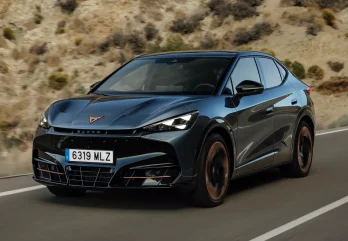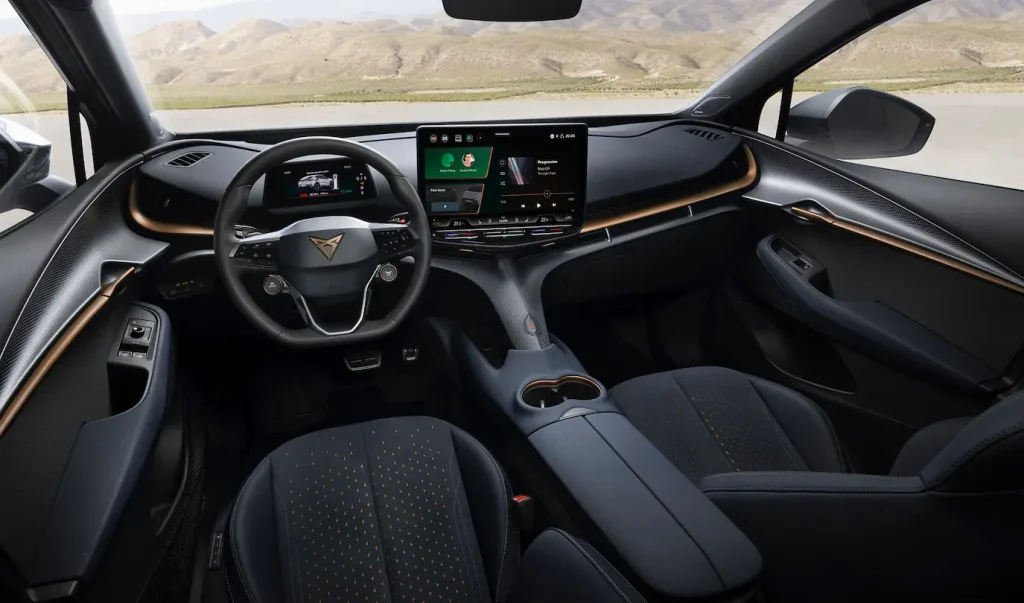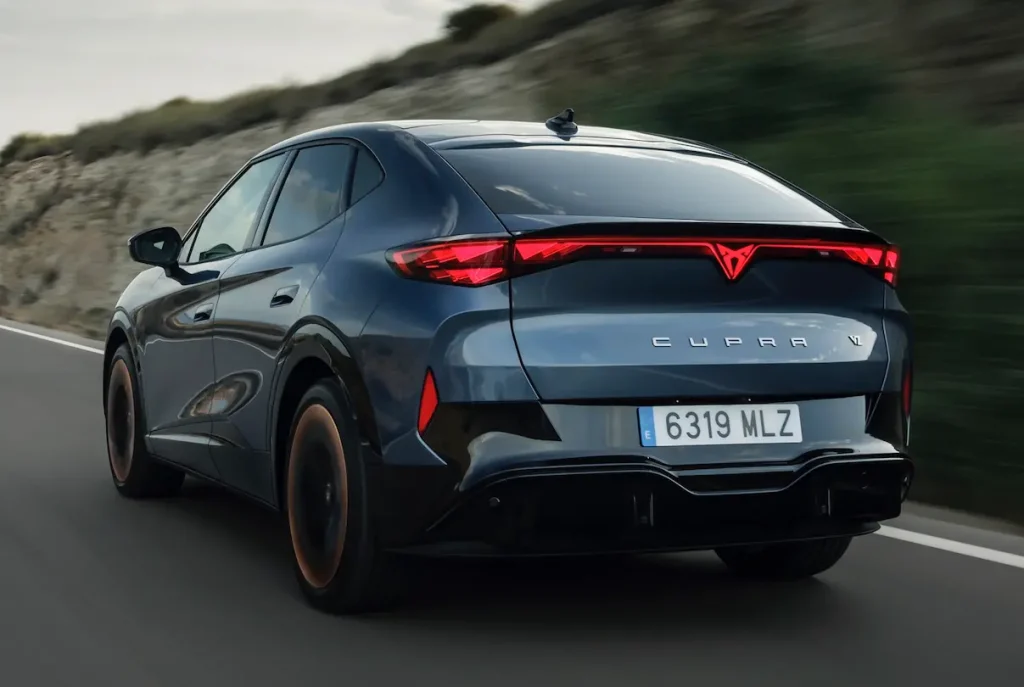
The Volkswagen Group is certainly getting its money’s worth from its electrified MEB platform, as before the Tavascan, it also underpinned the Audi Q4 E-Tron, the Skoda Enyaq, the Volkswagen ID.4, and even Ford’s Explorer and Capri!
The hardpoints on this platform might be fixed, but the rest has been left for Cupra, the sporting brand sired from Seat, to make its mark. And in the metal, the Tavascan does just that. From the front, you can see the visual link to the Born electric hot hatch, with its angry face. However, the Tavascan’s matrix LED light with three-triangle eye signature, and bolder front air dam, make it even more recognisable.
Move to the side of this Cupra, and the GT-like curvy roofline, and sharp flanks are both striking and attractive, considering how long and tall the Tavascan’s design is. With the side design only spoiled, in our opinion, by the shared door handles with the Volkswagen ID.4, and the standard 19in wheels fitted to the entry-level V1 equipment grade, which look a bit lost under this Cupra’s arches.
Highlights at the rear of this slippery Cupra, that’s bigger than the Formentor, are the large rear window, high-set rear light bar with same triangle detailing, and chunky rear apron.
Interior
Inside, the Tavascan is equally distinctive. Most obvious is the textured central coloured spine that joins the tall centre console and the dashboard – and reminds us of a Formula 1 car’s cockpit. It also hides decent upper and lower stowage. Elsewhere, the coloured textured trim carries on to the door panels, there are sports seats trimmed in suede-like microfibre trim on the V2, and optional leather-trim on the sports seats of the range-topping VZ2 that we also drove.

Dominating the dashboard is the large 15in touchscreen, which is shared with other Group models, but oddly seems to work less well with Cupra’s operating system and graphics. This is annoying, as because there are no fixed buttons, you’re going to be spending a lot of time interacting with that screen. Thankfully, the basic climate controls are fixed at the bottom of the display. Interior space is ample front and back, and there’s even a practical 540-litre boot.
Performance and drive
The Cupra Tavascan will be available in two versions with one battery size. V1 and V2 versions are rear-drive, have 282hp, and are capable of up to 353 miles of range if you choose the V1, or 339 miles if you choose V2 spec. Whereas range-topping and highest-performance VZ1 and VZ2 specs are dual-motor all-wheel-drive models, with 335hp, and a 320-mile range for the VZ1, or 299 miles if you choose the VZ2.
All have the same 2% BIK company car tax figure, with the expectation that most fleet business will be for the single-motor V1 and V2 models.
All Tavascans charge at up to 135 kW at DC fast-charging stations, and use the same 77 kWh battery with a 10 to 80% charge taking 28 minutes. A heat pump is part of an optional Winter Pack, that also includes a heated windscreen and heated seats, and is priced at £1,335.
We had the chance to drive the V2 equipment grade first, and even though this isn’t the performance range-topper, the impressive acceleration and performance grab your attention first. In fact, in terms of acceleration it feels very similar to the Audi Q4 E-Tron 45. Where these two Volkswagen EVs differ is in the way they drive. The Cupra feels sharper, and more focused on the road – although the only drive mode that seems to make a noticeable difference to the drive is the most focused ‘Cupra’ mode. It has its own button on the steering wheel and adds more weight to the steering and changes to throttle mapping. Elsewhere, the generally composed ride on the 19in wheels surprised. This Cupra’s keener dynamics equal a more involving and fun drive.

Next up was the VZ2, which despite having more than 100hp over the V2, didn’t feel noticeably quicker in acceleration terms. On standard 21in wheels, there’s more road noise and a harder ride – but it’s not unbearable. The extra grip from the second motor is welcome when powering out of corners, but the VZ2 doesn’t feel any sportier than the V2, which is disappointing.
The Tavascan is an interesting addition to the Volkswagen Group EV family, and the wider electric SUV sector. It looks great inside and out, offers a more involving drive, and is comparable with rivals in terms of price, such as the Audi Q4 E-Tron. However, the sweet spot of this range are the V1 and V2 rather than the range-topping dual-motor VZ1 and VZ2.
Positive: Sharp looks inside and out, spacious and practical interior, keen drive, seems good value against rivals.
Negative: Sportier models less convincing to drive, infotainment sometimes complicated to operate, no physical buttons.
Standard equipment: 19in alloy wheels, heated electric and foldable mirrors, LED headlights with signature, electric tailgate with virtual pedal, dark tinted rear windows, anti-theft alarm system, navigation system, drive profile selection (Range, Comfort, Performance, Cupra, Individual), seven-speakers, 5.3in Digital Cockpit with 15in central display infotainment system and Intelligent voice assist, wireless phone charger, three-zone Climatronic air conditioning, heated and leather-trimmed multi-function steering wheel with satellite buttons, front sports seats in cloth with manual height adjustment.
Engines: Electric: 282hp, 335hp
Equipment grades: V1, V2, VZ1, VZ2
Transmission: Single-speed automatic
| Model | Cupra Tavascan 77kWh V2 |
| P11D | £53,780 |
| Residual value | 47.7% |
| Depreciation | £28,147 |
| Fuel | £3,388 |
| Service, maintenance and repair | £3,188 |
| Cost per mile | 60p |
| Range | 339 miles |
| CO2 (BIK%) | 0g/km (2%) |
| BIK 20/40% a month | £18/£36 |
| Luggage capacity | 540 litres |
| Battery size/power | 77kWh/282hp |
| Score | 8/10 |





